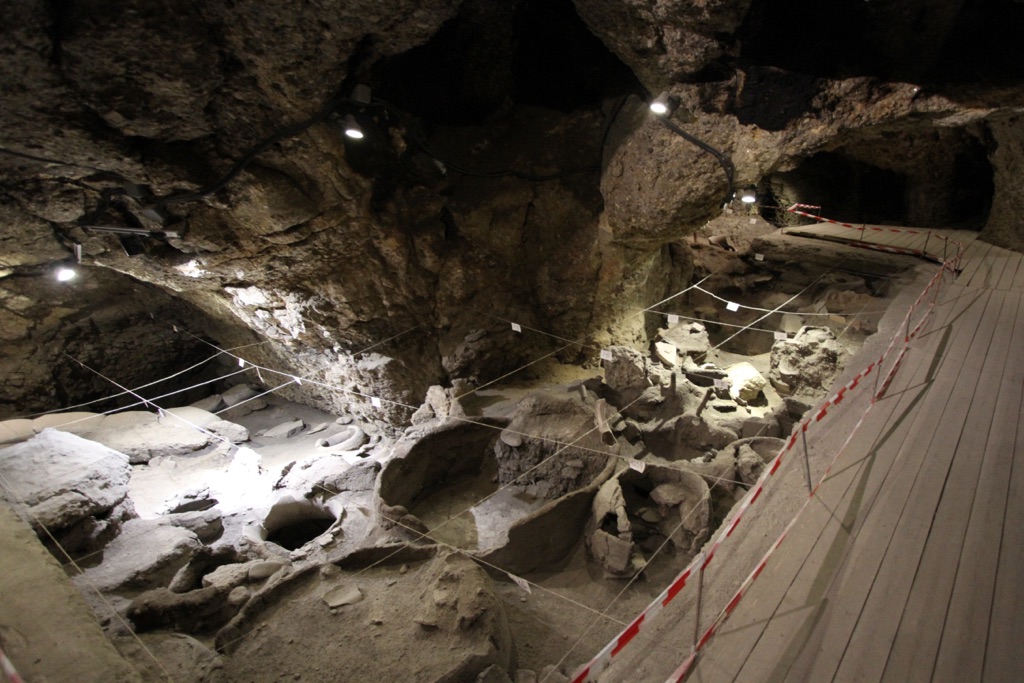The Areni-1 cave complex is a rich archaeological site nestled in the Areni village of Armenia. It gained international fame when researchers discovered the world’s oldest known leather shoe, a winery, and a skirt made of straw. These finds suggest the cave was a bustling center of human activity around 4000 BCE. The cave complex has provided invaluable insights into the Chalcolithic period, also known as the Copper Age, showcasing early human innovation and culture.
Get your dose of History via Email
Historical Background of Areni-1 Cave Complex
Archaeologists stumbled upon the Areni-1 cave complex in 2007. A team led by Boris Gasparyan of the Institute of Archaeology and Ethnography uncovered the site. The complex dates back to the Copper Age, a time of significant technological advancement. The Areni-1 cave complex was likely a site of both domestic and ritual significance. Over time, various groups have used the caves, leaving behind artifacts that tell a story of human development and culture.
The builders of the Areni-1 cave complex were skilled craftspeople of the Chalcolithic period. They created a space that served multiple purposes. The cave complex has seen various inhabitants over the millennia. It has been a silent witness to the ebb and flow of human history. The site’s significance extends beyond its initial use. It has become a treasure trove for understanding ancient human societies.
Not only was the Areni-1 cave complex a place of habitation, but it also played a role in the local community’s cultural and possibly religious practices. The discovery of a winery suggests the production of wine for ceremonial purposes. The cave complex has thus provided a unique window into the past. It has allowed historians and archaeologists to piece together aspects of early human civilization.
The Areni-1 cave complex is not just a static relic of the past. It has been the scene of historical importance. The artifacts found within its walls have reshaped our understanding of early human industry and culture. The site continues to be an area of active research. It promises to yield even more secrets about our ancestors.
The discovery of the Areni-1 cave complex has been a milestone in archaeological research. It has provided a tangible link to our distant past. The site’s excavation and study have been a collaborative effort. It has involved local and international experts. Their work has brought the Chalcolithic period to life, offering a glimpse into the daily lives of people who lived thousands of years ago.
About Areni-1 Cave Complex
The Areni-1 cave complex is a marvel of ancient engineering and craftsmanship. The site consists of a series of chambers and passageways carved into the rock. These spaces provided shelter and served various functions for the people who used them. The complex’s layout reflects a sophisticated understanding of space utilization and design.
The construction of the Areni-1 cave complex involved meticulous stonework. The builders used the natural contours of the rock to create a functional and durable structure. The materials used were primarily the indigenous rocks and minerals found in the region. This choice of materials ensured the complex’s longevity and integration with the surrounding environment.
One of the most striking features of the Areni-1 cave complex is the winery. The winery includes fermentation vats, a wine press, and storage jars. These elements highlight the architectural highlights of the complex. They also provide evidence of early winemaking techniques. The winery’s discovery has led to a reevaluation of the history of wine production.
The cave complex’s construction methods reflect the technological capabilities of the time. The builders had a deep understanding of their materials and environment. They created a space that has stood the test of time. The Areni-1 cave complex is not only an archaeological site but also an architectural wonder of the ancient world.
The Areni-1 cave complex’s design and construction methods have intrigued historians and archaeologists alike. The site’s preservation allows for a detailed study of ancient building techniques. It also provides insights into the social and cultural practices of the time. The complex is a testament to the ingenuity and resourcefulness of our ancestors.
Theories and Interpretations
The Areni-1 cave complex has sparked numerous theories about its use and significance. The presence of a winery suggests that wine production was a central activity. This has led some to theorize that the complex held religious or ceremonial importance. The wine may have been used in rituals or as an offering to deities.
There are mysteries surrounding the Areni-1 cave complex. The exact purpose of some of the artifacts found within remains a topic of debate. For instance, the significance of the world’s oldest leather shoe is still under examination. Researchers are trying to determine whether it was an everyday item or held some special significance.
Interpretations of the site have had to be matched to historical records and cultural understandings of the era. The artifacts found in the cave complex provide a narrative. This narrative is pieced together with other archaeological and historical data. This helps to create a more complete picture of the Chalcolithic period.
Dating of the Areni-1 cave complex and its artifacts has been carried out using various methods. Radiocarbon dating has been particularly useful. It has provided a timeline for the site’s use and the age of the objects found within. These dating techniques have been crucial in understanding the complex’s place in history.
The theories and interpretations of the Areni-1 cave complex continue to evolve. As new discoveries are made, our understanding of the site deepens. The complex remains an active area of research. It continues to challenge and refine our knowledge of ancient human societies.
At a glance
Country: Armenia
Civilization: Chalcolithic period inhabitants
Age: Over 6,000 years old (approximately 4000 BCE)

